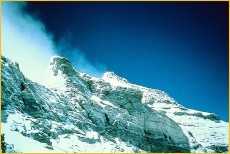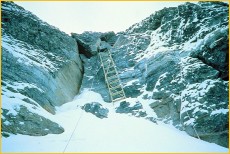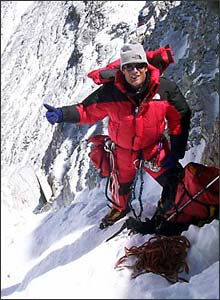
| |||||||
Jochen Hemmleb: Conrad Anker's Near-free Ascent of the Second Step
The Second Step (c. 8570-8610 m/28,120-28,250 ft.) is technically the crux of the Northeast Ridge route.
The initial climb up the step involves a 3 m high slab to the right of a narrow chimney, surmounted by ways of a narrow ramp and a short rock step. A prominent snow patch, some 7-9 m (25-30 ft.) high and 50° steep, leads up to the foot of the final 5 m/16 ft. headwall. This is surmounted with the aid of an aluminum ladder installed by the second Chinese expedition of 1975. From the top of the ladder a tricky move onto a ledge leads to easier terrain below the top of the Second Step and close to the crest of the Northeast Ridge.


The Second Step and the headwall with the Chinese ladder. On the left the crack climbed by Anker
© Dave Hahn (1994), from "Ghosts of Everest"
Until 1999, only one party was known to have climbed the Second Step without using the Chinese ladder, the Chinese team who made the first confirmed ascent of the step in 1960. But it hadn't been a free ascent, i.e. using only the hand- and footholds the rock had to offer, as the climbers used a shoulder stand and several pitons to overcome the headwall. Qu Yinhua, the leading climber, took of his boots and crampons to gain a better grip on the rock and avoid hurting his partner, later losing the front parts of both feet to frostbite. It took the Chinese three hours to surmount the last 16 feet of the Second Step. Film footage taken from above the step support their claim.
 Conrad Anker below the Second Step getting ready to climb (photo: Dave Hahn) |
Both Anker and Hahn moved up the lower section of the Second Step independently, using the fixed ropes already in place, and did not consider it technically too difficult, probably 5.4 or 5.5 (UIAA III-IV-), according to Hahn. Yet Hahn also remarked that the technical difficulty is only half of the problem: the final unprotected step out of the ramp onto the central snow patch is extremely exposed, with the whole 8000 ft. of the North Face dropping away below.
On the crux, the headwall, Anker tried two variations:
"First I tried going right, which looked like it was a line of weakness. But the rock was really loose and rotten, with bad fall potential. So I opted for the off-width that's just to the left of the Chinese ladder that was put there in 1975. And I was able to knee-bar to the top of it and got a size three-inch friend at the top of it and then I got a hand jam into the crack that I got the three-inch in, and then I had to step out. At that point the ladder was in the way. I had some edges in there, but I think due to the fact that I'm weak, more than anything, I stepped on the ladder. So one move of aid, but I did most of it free and I didn't have my pack and my cylinder on."
"It's probably 5.8 at normal elevation, but it feels like 5.10 up here", was Anker's first estimation over the radio. And then the 100,000$ question: Did he think Mallory could have done it? "Without specialized gear, i.e. camming devices... I mean I've looked all around here and that one crack is the only one that isn't really rotten. This great band is quite rotten. He probably would have just knee-barred up that off-width and then just pulled over. It's not that long but it certainly winds you when you're up there." (Anker, C., as quoted in Clark, L., "On Top of the World", NOVA Online, www.pbs.org/wgbh/nova/everest, May 17, 1999
Later the same day, PBS/Nova producer, Liesl Clark, summed up the general impressions of the listeners at Advance Base Camp, "So that was it, Anker's assessment, after so much conjecture: Mallory and Irvine would have had a tough time climbing the Second Step without modern hardware, but probably could have done it in over an hour's time." (emphasis added)
How this concluding statement came about is unclear in retrospect, as after the expedition Anker expressed the opinion that Mallory & Irvine could not have climbed the Second Step in 1924.
In the May 25 press conference at the Yak & Yeti Hotel in Kathmandu, Anker is reported as saying,
"He found the three-meter [sic] 'problem' of the Second Step to be 'moderate', a series of moves he would rate as 5.8 at sea level but a different matter altogether at 28,300 feet. Anker concluded by saying that, in his opinion, it is unlikely that Mallory or Irvine could have reached the summit in 1924, not just because of the technical problems of the Second Step, but because of other difficulties on the final part of the route." (as quoted in Potterfield, P., "Mallory's Artifacts and The continuing Search", Mountainzone, www.mountainzone.com, May 25, 1999)
In a Newsweek interview, published two weeks later, Anker described the Second Step as follows,
"The first part is blocky, the second part is overhanging loose rock, about 20 feet tall [6 m], and splitting the top part of this is a crack about five inches wide. This is where the Chinese climbed it in 1960 and again in 1975." To the question, "Is that what Mallory and Irvine might have done?", he responded, "If George Mallory was as bold and dashing a climber as history makes him out to be, there is a good chance he could have climbed it the same way I did, which seems to be the line of weakness." (Roberts, P.,"Everest - A Lot of Puzzles", Newsweek International, June 14, 1999)
In the September 1999 issue of "Climbing", Anker eventually concluded, "Even with a shoulder stand I think it's improbable that Mallory and Irvine would have done it." (Stableford, T., "Mallory & Irvine's Summit Day", interview with C. Anker, Climbing, 188, September 1999)
The final version of the Second Step climb, contained in Anker's book, The Lost Explorer (New York: Simon & Schuster, 1999; pp.151ff.), reads thus:
"In recent years, several climbers who used the ladder wondered whether another crack about ten feet to the right might serve as a possible route. Before I tackled the wall beside the ladder, I sidled out to the right to check out this alternative. [...] The rock was so rotten, none of my cams or Stoppers would have held. If I had come off on this crack, I would have taken a very bad fall. Finally I got to the base of the crack. It was filled with loose, disjointed rock, really dangerous. I just stood there, picking up grapefruit-sized stones in my hands and moving them around. The crack just wasn't an option. [...]
I decided that the only place to climb the Step was right were the ladder had been tied in. I started to the left of the ladder, where a crack angles up and right. [...] I started up with an arm bar and a knee jam; then I stepped onto some tiny edges with my right foot. [...]
It wasn't until I got about fifteen feet above Dave that I could place my first and only piece of protection. There was a chockstone wedged in the crack, underneath which I placed a perfect hand-sized cam. [...] At this point, I had to step right. Now I had a hand jam with my left hand, my right hand on a sloping hold, my left foot jammed in the crack, and I was only about six inches away from the ladder. The place I needed to put my right foot was between the rungs of the ladder. It was really awkward - the ladder was in the way. I reached my foot between the rungs, but at that point I was panting, totally winded. I just had to step on the rung and rest. [...] Then I moved on up. There was one tricky move and then the cliff sloped back. [...]
I hadn't free-climbed the Second Step. That achievement still awaits a stronger climber. I had done all but one move, yet I'd failed in what I set out to do. Nonetheless, the effort had given me a good idea of how hard the climb was. At the time, erring on the side of caution, I tentatively graded the pitch 5.8. Later when I got back to the States and saw at what level I was climbing in Yosemite and Indian Creek, Utah, I changed my mind. The Second Step is probably a solid 5.10." (and A0, one point of aid, i.e. stepping on the rung of the ladder; author's note)
Even without the debilitating effect of altitude, 5.8 (UIAA V+) would have been at the upper level of Mallory's technical ability, 5.10 (UIAA VI+) clearly beyond - and in any case beyond anything we know of Irvine's capabilities.
In Anker's opinion, the Second Step had been too difficult an obstacle for Mallory & Irvine to have climbed it in 1924.
![]()
| Proud Climbing Team of the Mallory & Irvine Research Expeditions: | ||

